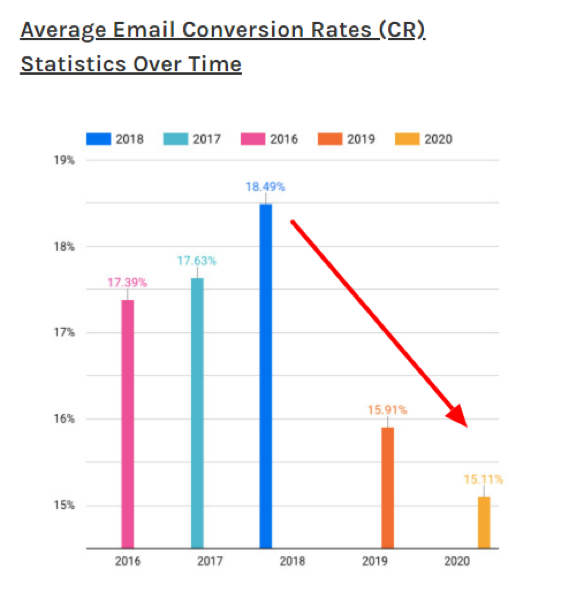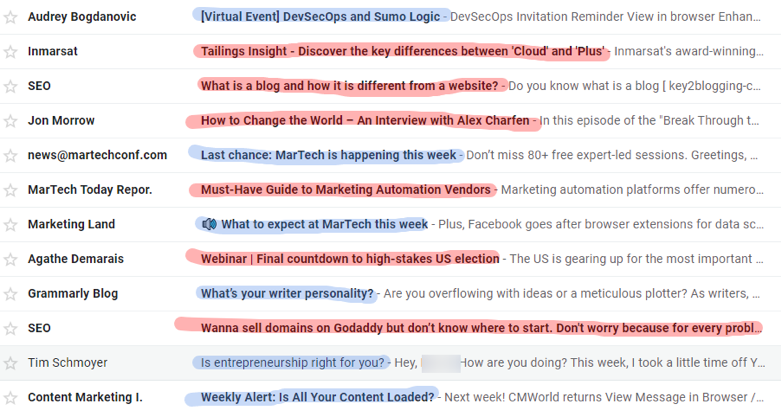Without a doubt, emails are an effective way to engage an audience and drive purchases. The average ROI on a successful email marketing campaign is 3800 percent or $38 for every $1 invested. No wonder, 59 percent of marketers strongly believe that emails influence purchase decisions.
Owing to the high ROI they promise, emails continue to reign as one of the best marketing channels for small business owners. In fact, businesses are planning to allocate a higher percentage of their marketing budget to email marketing campaigns.
However, no business, small or big, can afford to invest in a channel and not see sufficient ROI in terms of conversions and improved brand recognition. One look at this chart is enough to understand how the email conversion rates have tanked after 2018. The domain is highly competitive and businesses often struggle to engage or drive conversions through emails.

Source: https://www.barilliance.com/email-marketing-statistics/#tab-con-3
Therefore, as a small business owner, you should devise foolproof email conversion strategies that give you the best bang for your buck. Here are a few pointers to get you started.
- Hone Your Story-Telling Skills
If you want to engage and inspire your audience to take any action in your favor, narrate a story. Who doesn’t enjoy a good story? It makes a business look human and relatable.
Check out how Tim Schmoyer, the video marketing expert, narrates how he took some time off YouTube to spend time with his loved ones (he’s added an image too!). Believe it or not, this narration is deeply linked with his newsletter (a guide on whether or not entrepreneurship is for you). But it got me hooked! I read the entire email and downloaded the ebook too.

It’s amazing how stories can be connected with email content. Use storytelling and well-written narratives to engage your email recipients and encourage them to take an action.
- Deliver Customized Content
In an Evergage survey of 314 markets, 98 percent of the respondents agreed that email personalization helps advance customer relationships, encouraging them to stay loyal to the brand.
However, a majority of those surveyed feel that marketers aren’t getting email personalization right.

Source: https://www.evergage.com/wp-content/uploads/2019/04/2019_Trends_in_Personalization_Report.pdf
Use email segmentation to deliver personalized content and increase the chances of conversions. Send out surveys or polls to understand your audience better. The insights can be used to create personalized content for your email recipients.
Personalization improves the relevance of your content, making it shareable and linkable. This will not only boost your content reach but also improve your inbound link profile. Also, it may seem that there’s no direct connection between email marketing and SEO. However, the content shared through emails can drive a qualified audience to your site.
Emails allow you to promote targeted SEO content and improve your off-page SEO factors, thus sending positive signals to Google. Therefore, it’s critical to involve an expert SEO agency that can help you build content that meets your audience’s needs and drive conversions.
- Make It Mobile-Friendly
Recent research shared by Upland Adestra reveals that mobile users account for 62 percent of email opens.

Source: https://uplandsoftware.com/adestra/resources/blog/top-10-email-clients/
Another report by Spotler reveals that 31 percent of customers prefer shopping on their smartphones. Thus, email marketers can no longer ignore the significance of optimizing emails for mobiles.
Mobile-friendliness can positively influence email interactions and consequently the revenue. Here are a few quick tips to make your mobile email design conversion-worthy.
- Follow a Simple Layout
Create an email design with a single column layout with a responsive width and font. Alternatively, for multiple column layouts, you can use a responsive template to allow the content to appear in the order you want to.
Use these responsive email templates from Email on Acid to create emails that look and behave suitably on mobiles.
- Optimize the Subject Line
Subject lines cannot be ignored as they are the first things your recipient comes across. Different mobile devices show varying character lengths for the subject line. However, the rule of thumb is to have a subject line of 30-35 characters (and about 35 for the pre-header text).
Here are a few examples of subject lines (marked in blue) where 35 characters are viewable. The ones marked red will not visible on mobiles.

- Keep It Concise
Mobile screens are small. Hence, to engage your mobile recipients, it’s best to keep your content short and scannable.
For instance, breaking the content in short paragraphs or sharing a bulleted list can make emails more consumable, thus improving UX and increasing the chances of conversions.
Check out this promotional email from Nykaa, the online beauty store. The copy is short, yet compelling with a clear call to action, giving the reader an option to click and get further details on the offer.

- Test What You Are About to Send
Make sure you test the emails across multiple devices using email preview tools like Mail Ninja, Inbox Analyzer, and HubSpot. This will ensure that your emails look great on every screen.
- Measure the Success of the Campaign
In this data-driven age, measuring and monitoring the top KPIs for email success is the only way to understand its effectiveness and value. Emails, as a marketing channel, are perfectly traceable. Hence, marketers should track the following metrics to measure their email efforts.
- Conversion Rate - It is the percentage of recipients who clicked on a link in an email and completed a desired action. It could be a link for re-ordering a product, filling a lead-generation form, or downloading a recent report.
So, anyone who completes the desired action counts as a conversion.
- Click-Through Rate (CTR) - It is the percentage of recipients who clicked on one or more links shared in the email. The metric gives you a direct insight into the portion of email subscribers engaging with the content and expressing interest in your offerings.
- Bounce Rate - It is the percentage of emails that couldn’t be successfully delivered to the recipient’s inbox. The metric points out to deep-seated issues with your emails. Watch out for high bounce rates as it may make you look like a spammer in the eyes of an internet service provider, impacting your business’s online reputation.
- Open Rate - It is the percentage of email recipients who open an email. While optimizing your email subject line for a better open rate is a great idea, it’s no guarantee that the recipient will take the desired action in your favor. That’s why you also need to optimize for CTR.
In that sense, the open rate is a misleading metric. Therefore, it’s wise to track it along with the other KPIs.
- Unsubscribe Rate - The percentage of recipients unsubscribing from your email list. Again, like the open rate, the unsubscribe rate doesn’t give a complete picture of your email marketing performance.
For instance, not all your subscribers will go through a formal unsubscribe process. They may just stop engaging with your emails and yet be a part of your list. Yet, it is important to look at this metric along with the ones mentioned above.
Each of the metrics shared above can be easily monitored using tools like MailChimp, HubSpot, Streak, Campaign Monitor, and Right Inbox. These email tracking software will help you measure and improve your email game and increase your marketing ROI.
Wrapping Up
Though emails are one of the oldest forms of marketing tools they haven’t shown any signs of getting outdated. They continue to reign as a marketing channel that delivers a great ROI. No wonder, small and big business owners stand by email marketing and are using it to gain more market share.
However, very few businesses can generate leads and convert visitors with email. If you are struggling to generate leads through this channel, use the winning strategies shared in this post and boost your email conversion rate.
